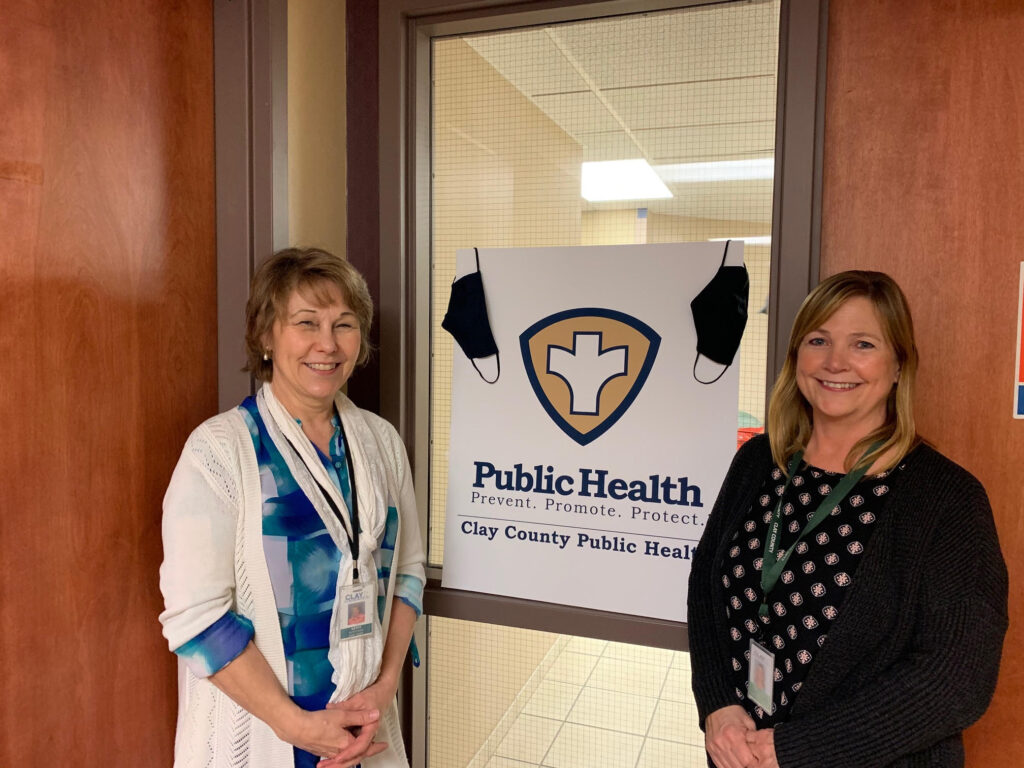
Public Health Director Kathy McKay and Director of Nursing Jamie Hennen say the first doses of the Moderna vaccine are expected in Clay County within a few days. Photo/special to the Extra
Nancy Edmonds Hanson
There’s light at the end of the COVID-19 tunnel. Nine months after the first case of the novel coronavirus was reported in Clay County, the first doses of vaccines were expected to arrive here late this week.
Public health director Kathy McKay said Monday that her office was expecting to receive a small shipment of the Moderna vaccine in a few days. As part of the four-county public health board encompassing Clay, Becker, Wilkin and Otter Tail counties, the agency will share in the first small allotment of only about 400 doses. “But we expect to receive additional shipments every week from then on,” she said Monday.
It’s been a long, rough road to arrive at this point. Nearly one in 10 Clay residents has been diagnosed with the virus since the first on March 15, and 73 people have died, according to the most recent tally. “Finally, we’re at the point we wanted to get to,” the nurse notes. “Vaccination is our only answer. Without it, we could never arrive at herd immunity” – defined as immunization of 70% of the
population.
Two vaccines have been approved so far by the Food and Drug Administration. The first, supplied by Pfizer Pharmaceuticals, began treated front-line health-care workers last week. It was shipped directly to hospitals, which are equipped with the ultra-cold storage necessary to maintain it at 94 degrees below zero. The Moderna vaccine can be safely stored in standard freezers like those in the county health department.
Moderna’s candidate gained FDA approved just last weekend. That’s the one McKay and her staff are waiting for, along with commercial pharmacies that have contracted to assist under the federal Pharmacy Partnership Program. Here in Moorhead, Walgreen’s and CVS will begin vaccinating residents of long-term care facilities, the group hit hardest by the pandemic and accounting for more than half of the state’s nearly 5,000 deaths. Public Health is waiting for guidance on the role it will play.
Meanwhile, the rest of these earliest doses – expected to be given to patients next week – are strictly prioritized under the Center for Disease Control’s Phase 1-A guidelines. Among them: residents of emergency shelters; group homes and assisted living centers; dental offices and pharmacies; mental health clinics; dialysis centers; juvenile and adult correctional facilities; and urgent-care clinics. Second doses must be administered 28 days later, in the case of the Moderna shots; the CDC has assured agencies that supplies for those follow-ups will also be sent in a timely manner.
“The CDC still hasn’t finalized guidelines for groups 1-B and 1-C,” McKay said. “We assume many people in lower priority group, starting with those over 65 and with risk factors, will be treated by their regular health providers or pharmacies.” Public Health will probably be involved in offering vaccinations as well, but those plans are still up in the air.
That’s what happened with the United States’ previous pandemic, H1N1 influenza, back in 2009. McKay and director of nursing Jamie Hennen remember long days of mass vaccination clinics around the county, including campaigns in every school. “On one day, we vaccinated 760 individuals,” she said. Other public events took place at the Family Service Center.
H1N1 was very different from COVID-19, she explained. “We feared its severity at first because it was new,” she said. “But we learned it was just a new strain of influenza, so the labs were able to come up with a vaccine quickly.” It struck in March. A vaccine gained FDA approval in September, and by October inoculations were available for the top priority population. It was then included in the regular flu vaccine the following year.
It’s interesting to note, the two nurses added, that the same common-sense measures that are advised to fight Covid-19 – masking, social distancing and frequent hand-washing – seem to be keeping this year’s seasonal influenza to a minimum.
“We’ve been seeing the numbers of positives coming down, but they’re nowhere near where they need to be,” McKay pointed out. “At the same time, I think we’re seeing more and more compliance with the rules. With so many ill and so many deaths right here, people are getting a lot likelier to know someone personally who has been very ill or has died.”
She credits Minnesota’s free saliva-testing program at the former Edison School, 1110 14th St. S., with helping slowly bring the local spread into more manageable numbers. Since opening Oct. 11, it has tested as many at 5,800 individuals a week.
Despite the good news about vaccine distribution, the director admitted, “I wish we had a better handle on how this will go. It’s still unclear to all of us when inoculations will be available to everyone.” Hypothetically, she predicted late winter or even early spring, with some predicting it could go into the summer months.
But prevention measures taken now may have a big effect on that outcome. That includes foregoing large gatherings in coming days, including Christmas and New Year’s festivities.
“We need to keep doing what we’ve been doing, even if we’re getting really tired of it,” she urged. “Masks are imperative. So is washing your hands. Of course, we all should have been doing that all along, but we’ve gotten complacent. Do what you’ve been doing to stay safe, and hold on. The end is in sight.”

